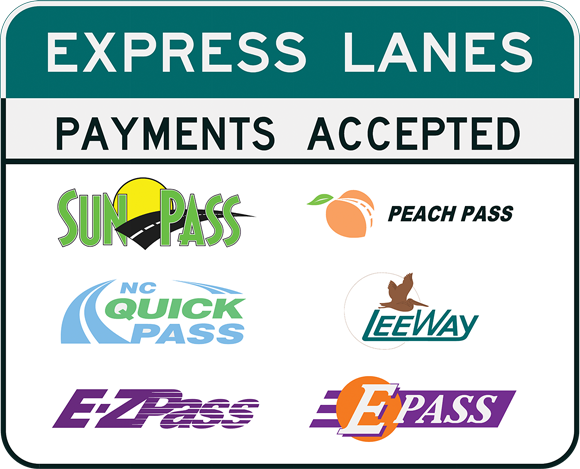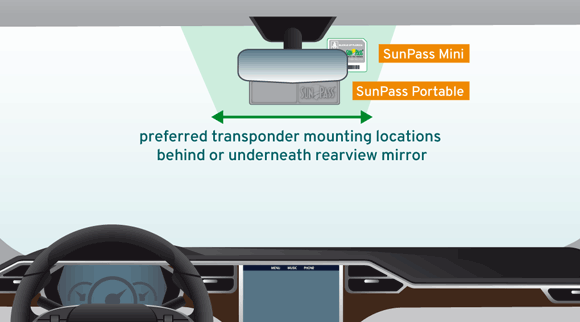What Transponders Are Accepted on
I-4 Express?
To use I-4 Express, drivers must have a
Florida-accepted transponder mounted on their
windshield.
The transponders allow motorists to use the managed
lanes without stopping at a toll booth. When a
vehicle passes under certain gantries, the
electronic tolling system recognizes the
transponder. That allows the system to charge the
user’s prepaid account.
By way of an imperfect analogy, it’s like what
happens when a can of soup passes over the grocery
store scanner. The scanner reads the bar code and
assesses a charge.
SunPass, the official transponder of I-4 Express,
comes in two sizes. The SunPass Mini looks like a
small card that attaches to the inside of your car’s
windshield and cannot be moved from one vehicle to
another. The larger SunPass Portable and SunPass PRO
are mounted to the windshield by suction cups and
can be easily removed. For more details, click
here.
The goal of I-4 Express is to provide a reliable
travel option to those who drive on Interstate 4
frequently or when they visit the area. One way the
Florida Department of Transportation (FDOT) can
deliver a more predictable trip is through
electronic tolling.
All tolls on I-4 Express are collected
electronically so motorists do not have to stop to
pay when passing through a gantry. There is no
TOLL-BY-PLATE or cash option, so motorists must have
a transponder to use I-4 Express. A $25 toll
violation plus the cost of tolls will be imposed on
drivers who don’t have an Florida-accepted
transponder.
In addition to
SunPass, several interoperable transponders are accepted:
E-PASS, E-ZPass, LeeWay, NC Quick Pass, and Peach
Pass.
Visitors without transponders have the option to use
a Visitor Toll Pass. Visit
visitortollpass.com/
for more information.
|
|
Then and Now: An Updated Drive Through the I-4
Ultimate Improvement Project
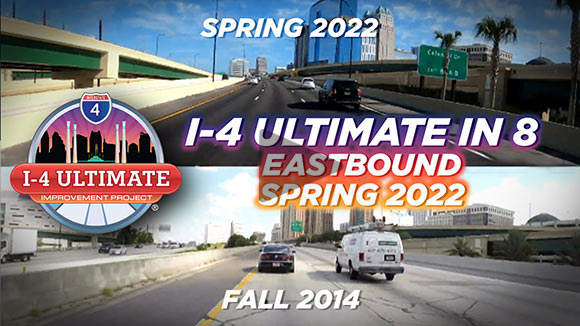
|
|
Click on image above to view video.
|
|
|
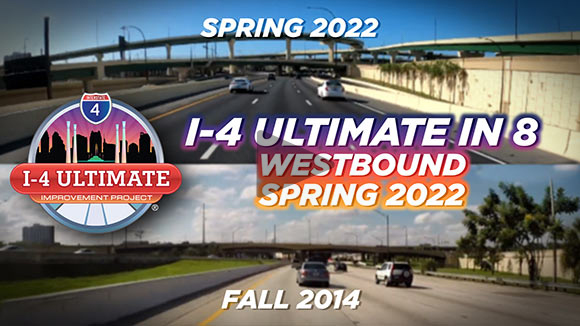
|
|
Click on image above to view video.
|
|
|
Get a first-person perspective of improvements on
Interstate 4 (I-4) as if you’re in the driver’s
seat. Take a drive through the entire 21-mile I-4
Ultimate Improvement Project – both eastbound and
westbound – and see the improvements along the way.
Each video has a split view: The top shows how I-4
looks as of spring 2022, and the bottom shows how
the roadway appeared in 2014 before construction.
The I-4 Ultimate Improvement Project has reached
substantial completion. The general use lanes,
interchanges, pedestrian features, and ramps along
the 21-mile stretch from west of Kirkman Road (State
Road 435) in Orange County to east of S.R. 434 in
Seminole County are on full display. Viewers can see
the transportation upgrades by watching these
videos:
eastbound drive
and
westbound drive.
In the videos, you can see signs for the new I-4
Express lanes. These managed lanes (two in each
direction) are in the center of I-4, spanning all 21
miles of I-4 Ultimate. For more information about
the express lanes or to plan your trip, please visit
i4express.com/.
While watching, also keep an eye out for the
following major improvements: a reconfigured Kirkman
Road interchange and new pedestrian bridge, a new
Grand National Drive overpass, a redesigned Maitland
Boulevard interchange, flyover ramps between I-4 and
S.R. 408, and Michigan Street and Kaley Avenue
interchanges combined into a safer interchange.
|
|
Auxiliary Lanes Improve Traffic Flow on
I-4
The I-4 Ultimate project has made it easier than
ever before to enter and exit the interstate.
Interchanges have been reconstructed to shorten time
waiting for lights, on ramps have been lengthened to
increase capacity, and exits have been moved from
the left to the right to reduce weaving. In many
places, auxiliary lanes have been added between
exits.
Auxiliary lanes make I-4 easier to use by allowing
drivers taking shorter trips to avoid merging with
the other vehicles, especially if they just want to
enter the highway and drive to the next exit. This
also helps other drivers on the highway because it
reduces the number of vehicles weaving in and out of
the rightmost travel lane. The auxiliary lanes also
allow entering drivers who are continuing further on
the interstate more time to merge safely into
through lanes.
How do you use them? For example, if you are taking
I-4 eastbound from Lee Road, you enter the on ramp
in the usual manner, and then stay in that rightmost
lane. You will notice the lane markings on your left
are composed of shorter, more frequent white dashes.
This indicates an auxiliary lane and distinguishes
it from the through lanes. Stay in the auxiliary
lane and exit at Maitland Boulevard without having
to merge even once.
The I-4 Ultimate project has added auxiliary lanes
where it was possible along the 21-mile stretch of
highway. In other places, existing auxiliary lanes
were lengthened to form complete connections. Check
the map to see where auxiliary lanes can be found
throughout the corridor.
|
|
I-4 Will Keep Making History into the
Future
The I-4 Ultimate project is not just a major
improvement for the present, it’s also a dependable
pathway to the future.
With 21 miles of new pavement, four new express
lanes, 15 reconfigured interchanges and 140 bridges
and ramps now completed, the massive I-4 Ultimate
project has improved safety and mobility on the
busiest road in Central Florida.
Improving mobility while adding to traffic capacity
creates more connectivity between vibrant
communities along the Interstate 4 (I-4) corridor.
That’s essential to an area already known for growth
that tends to spread in many directions.
To help manage the traffic that grows along with the
population, the Florida Department of Transportation
(FDOT) provided a new option for more reliable
travel times via I-4 Express. Having that option may
prove significant very soon. The tourism and
convention industry shows signs of increasing again.
Before long, the region may once again reach
pre-pandemic levels when it attracted more than 75
million visitors per year.
Modernization Continues
While I-4 Ultimate boasts the necessary
communications infrastructure to support automated
and connected vehicles in the future, the more
traditional types of improvements are far from
over.
For instance, another program, which includes
projects that extend 20 miles beyond the east and
west ends of I-4 Ultimate, will bring significant
changes to several interchanges, including Sand
Lake Road (State Road 482), Daryl Carter Parkway,
and the ChampionsGate area at the Osceola-Polk
county line.
Known as the
I-4 Beyond the Ultimate
program, it has already resurfaced lanes and
reconstructed the E.E. Williamson Road bridge over
Interstate 4 (I-4) in Seminole County.
Reconnecting Older Neighborhoods
The recently completed work at I-4 and S.R. 408
allows for what many in the area had long hoped
for: The reuniting of neighborhoods that were
divided by the original construction of I-4 in
Orlando in the mid-1960s.
But the careful rebuilding and rearranging of
support pillars for the interchange and ramps in
downtown Orlando opened a wide expanse under the
elevated interchange. The city of Orlando even is
planning a recreation and entertainment area below
known as the
Under-i project.
That new open expanse and the plan for attracting
new businesses and recreational activities under
I-4 also may help stimulate minority neighborhoods
to grow back together.
|
|
National Distracted Driving
Awareness Month
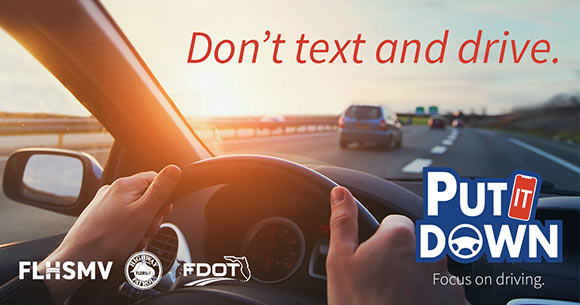
|
|
The National Highway Traffic Safety
Administration (NHTSA) recognizes April as
Distracted Driving Awareness Month.
|
|
|
Distracted driving has become a deadly epidemic
on roads.
Distracted driving occurs when motorists do not give
their full attention to driving. Distractions are
not limited to cell phone usage but encompass any
distraction that disrupts a motorist’s vision, full
attention, or ability to keep their hands on the
steering wheel.
In 2019,
distracted driving
killed 3,142 people – a 10% increase from 2018.
Young drivers seem more prone to using their phones
while driving. According to NHTSA research from
2017, drivers 16 to 24 years old have been observed
using handheld electronic devices while driving at
higher rates than older drivers have since 2007. But
make no mistake: It isn’t just young people who are
driving distracted; drivers in other age groups
don’t lag far behind. Common examples of distracted
driving include using a handheld communication
device, talking on the phone, driving while
impaired, having unsecured pets, adjusting volume
and climate controls, eating, daydreaming, attending
to children, and any other activity that prevents a
driver from focusing only on driving.
Texting while driving is against Florida law. The
first offense results in a $30 base fine, and a
second offense has a $60 base fine plus 3 points
entered against the motorist’s license. Using a
wireless handheld communication device while in a
school or work zone is a moving traffic violation
with a $60 base fine, not including court costs and
fees, plus 3 points entered against the motorist’s
license.
To help prevent distracted-driving crashes, the
Florida Department of Transportation has designated
64 phone safe zones throughout Florida, more than
any other state. These zones include Rest Areas,
Welcome Centers, and Turnpike Service Plazas. If a
driver receives an urgent message or an important
situation arises, they can safely pull over at any
of these
official locations.
Tips to Avoid Distracted Driving
-
Put your phone on “Do Not Disturb” or “Safe
Driving Mode.”
-
If there is an urgent call, text, or situation you
need to attend to, pull over into one of Florida’s
64 designated Phone Safe Zones before responding.
These zones include Rest Areas, Welcome Centers,
and Turnpike Service Plazas.
-
Get 7-8 hours of sleep per night and pull over to
a safe location to rest if you feel drowsy. When
traveling, take a break every 2-3 hours or 100
miles.
-
Complete a trip checklist beforehand: Program your
GPS, set climate and volume controls, check the
position of your mirrors and seats, and put your
phone on a “Do Not Disturb” setting.
-
Properly secure any pets or young children. If an
emergency arises, pull over instead of trying to
resolve the issue while driving.
|
|
|


